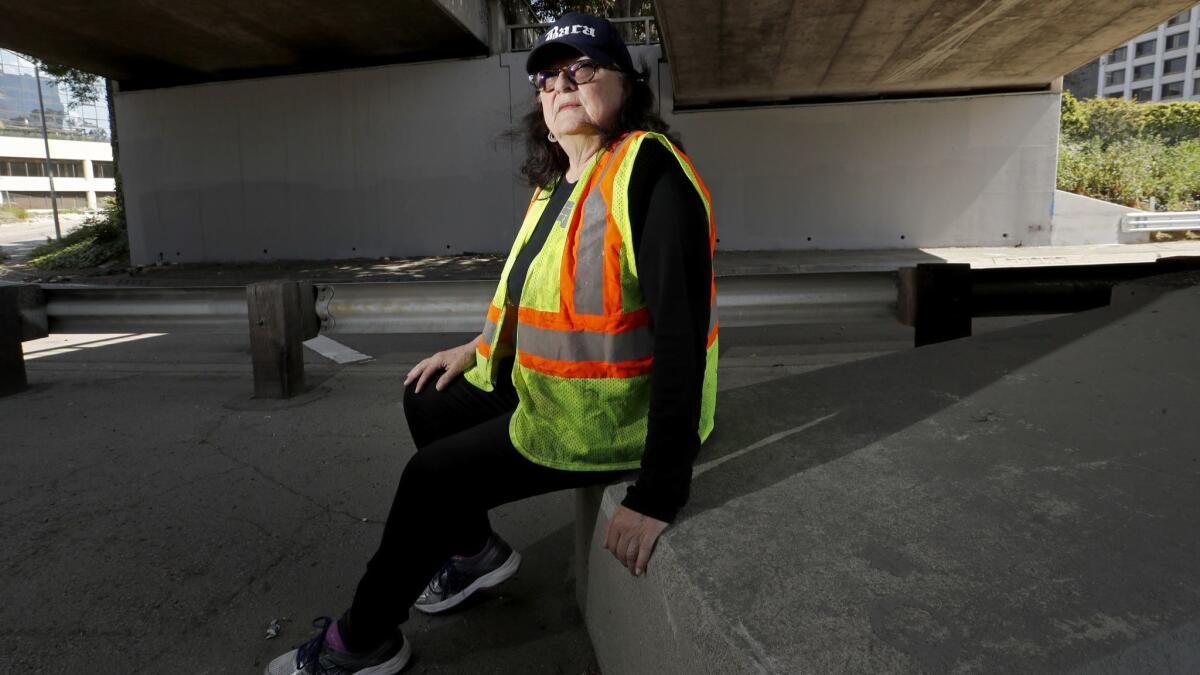Metro says it painted over graffiti. It covered a historic L.A. mural in the process
- Share via
The Los Angeles County Metropolitan Transportation Authority has admitted it was responsible for the whitewashing of a historic Los Angeles mural nearly two weeks after the artist announced its erasure.
Muralist Judy Baca said she was devastated over the loss of her artwork, titled “Hitting the Wall,” which was completed in 1984 to commemorate the first time women were allowed to run in an Olympic marathon.
Baca had been considering legal action against the California Department of Transportation, which has jurisdiction over the 110 Freeway in downtown L.A. where the mural is painted.
Now, Metro has stepped into the painted drama. The agency said late Tuesday that its graffiti-abatement contractor painted over the wall on Feb. 26.
“As part of the Freeway Beautification Program, Metro has been providing, through its contractor, supplemental landscaping, graffiti abatement and litter removal along this stretch of the 110 Freeway on Caltrans’ right of way,” the agency said in a statement. “Due to the extensive graffiti coverage on the mural, our contractor did not recognize that there was a mural under this section of wall. We apologize on behalf of our contractor and will move forward to resolve this matter with SPARC.”
Metro said it will work with the Social and Public Art Resource Center, a group headed by Baca that promotes art in the community, to resolve the issue.
SPARC had thought that Caltrans was responsible for whitewashing the mural last month because accessing that portion of the freeway is dangerous and requires permission and supervision from the state transportation agency. Baca’s mural is near the 4th Street exit.

The artwork is copyrighted and registered with the city’s Department of Cultural Affairs. In accordance with the Visual Artists Rights Act, a 1990 law that protects recognized works of public art from damage, destruction or defacement, Baca should have received a 90-day notice if her mural was to be removed. But she said she never got any such notice.
She was not immediately available Wednesday for comment.
“Hitting the Wall” was one of at least 10 murals commissioned by the International Olympic Committee, and Baca received $15,000 for her work. Only a handful of the Olympic murals are left, making Baca’s piece even more valuable.
“A mural of that size is worth millions and millions of dollars,” Brooke Oliver, Baca’s attorney, told The Times last week. “It is reprehensible that Caltrans doesn’t recognize that it is a tremendously valuable and revered mural in a high-profile place in Los Angeles and doesn’t give it the respect that it deserves.”
But Caltrans insisted it was not responsible for painting over the artwork. The agency said last week it had reviewed GPS data for all crews that worked in the region from Jan. 7 through March 4 and found none in the vicinity of the mural.
On Wednesday, Caltrans spokeswoman Lauren Wonder said the agency had given Metro an encroachment permit in October 2018 to provide litter, landscape and graffiti services along the 110 and other freeways that are part of the Freeway Beautification Program. That permit gave Metro the right-of-way and allowed the county’s transportation authority to paint over the mural.
John Bulinski, Caltrans’ district director, said like Metro, the agency is committed to helping Baca restore her mural.
Carlos Rogel, SPARC’s interim executive director, said the organization will meet with Metro and Caltrans to determine the next steps in the restoration process.
The project could take a week to complete and cost up to $50,000, according to SPARC. The mural is covered with a protective coating developed by the art group, but because the artwork was entirely painted over, it’s unclear how much damage removing the gray paint could cause to the mural beneath it.
“While department staff may not be responsible for this, as members of the community, we are committed to making things right,” Bulinski said.
alejandra.reyesvelarde@latimes.com
Twitter: @r_valejandra
More to Read
Sign up for Essential California
The most important California stories and recommendations in your inbox every morning.
You may occasionally receive promotional content from the Los Angeles Times.














